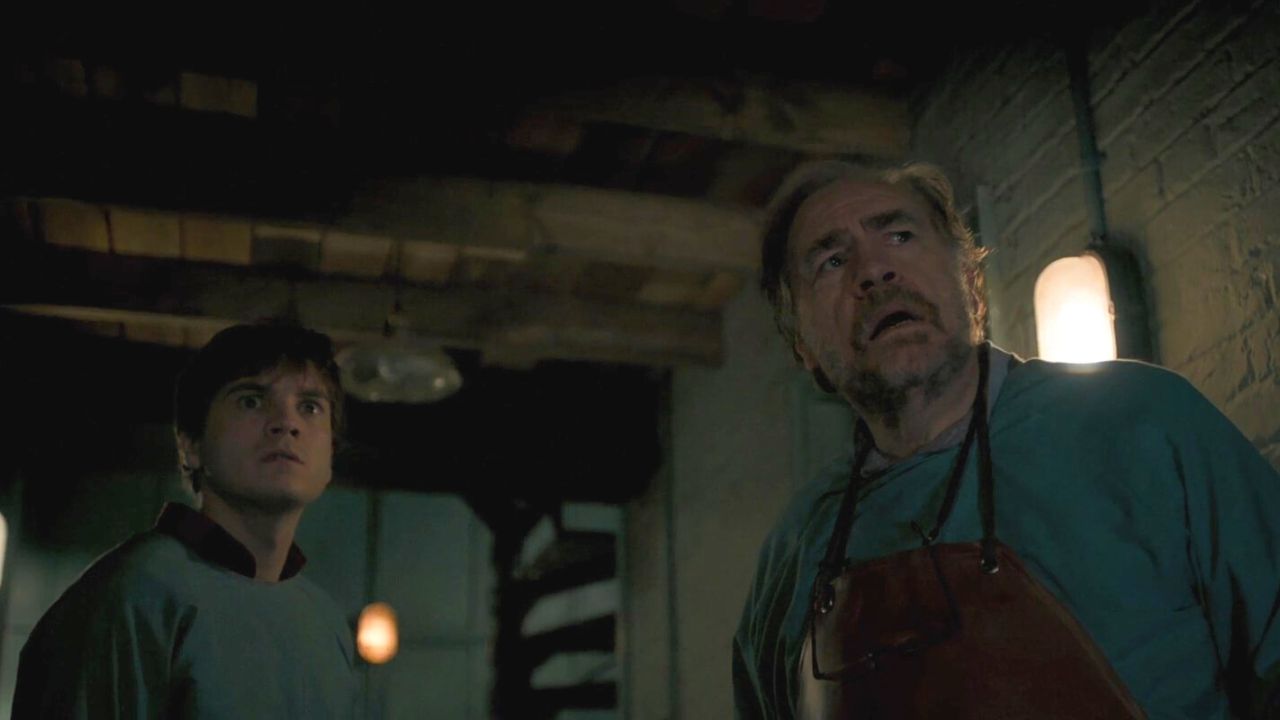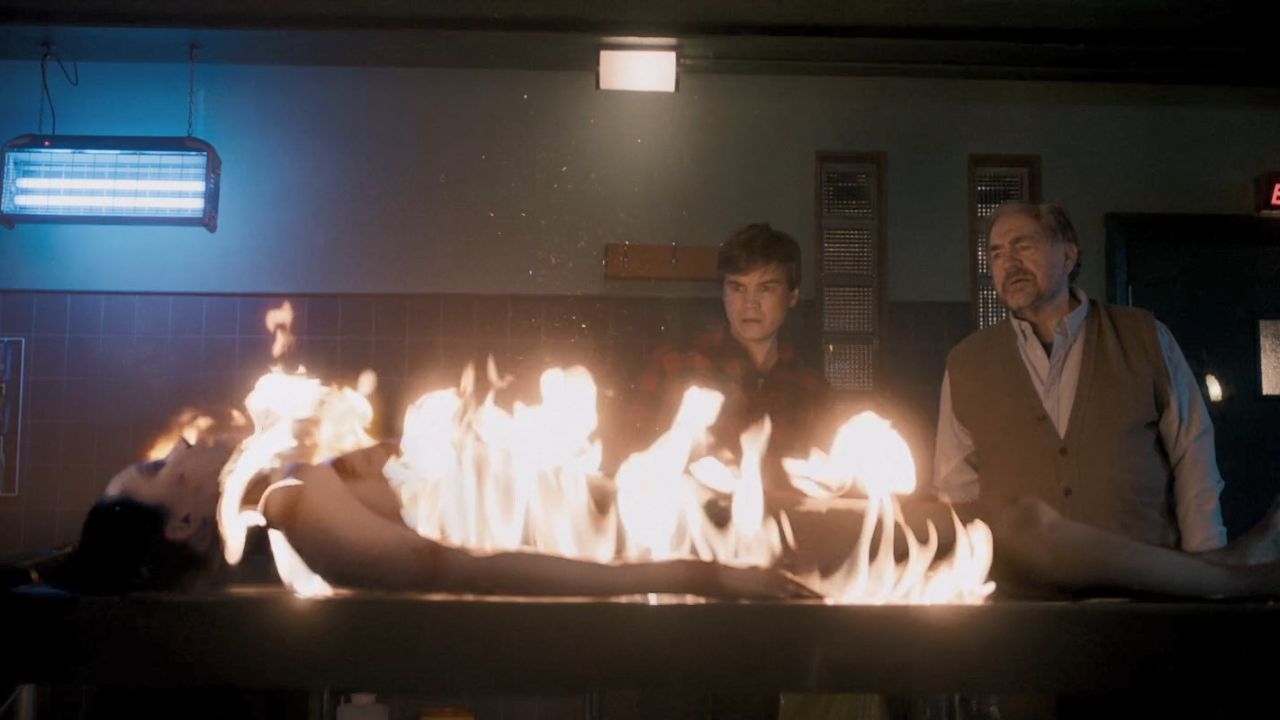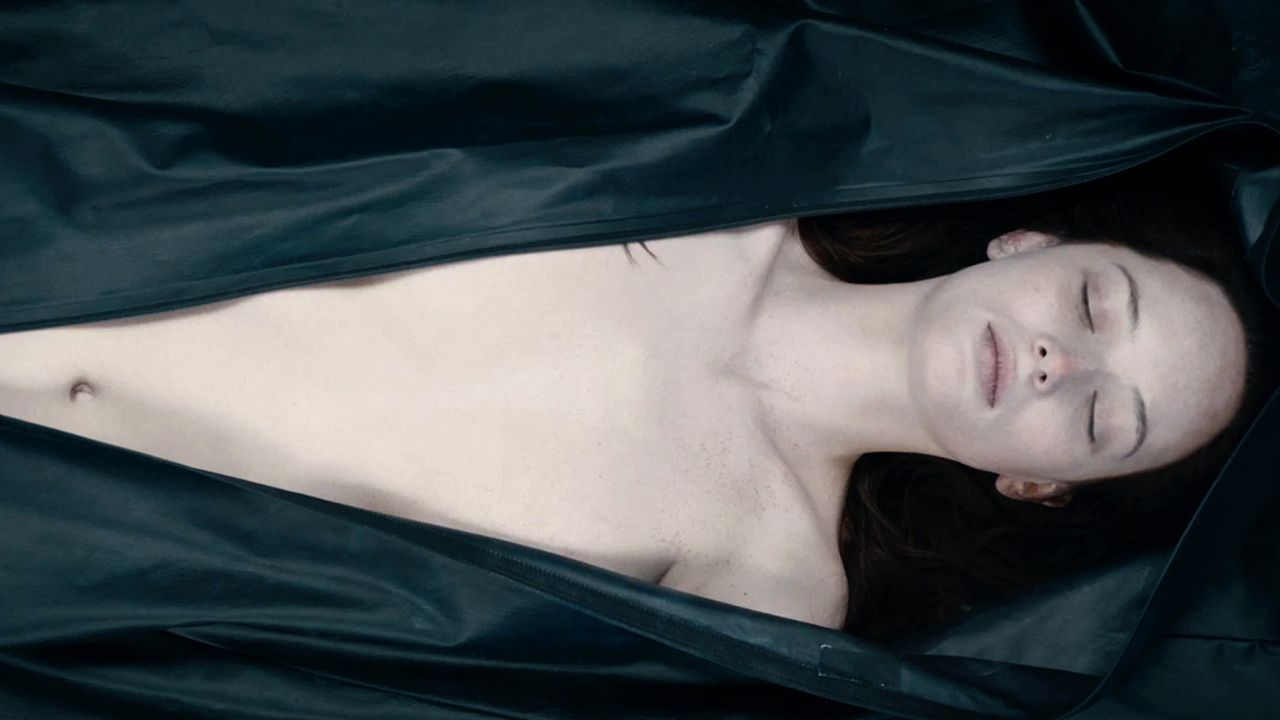This post includes a brief plot summary and an explanation about the ending of “The Autopsy of Jane Doe” (2016). Beware of spoilers.
Directed by André Øvredal, the supernatural horror film stars Emile Hirsch as Austin Tilden and Brian Cox as Tommy Tilden.

The film “The Autopsy of Jane Doe” follows the lives of father and son, Tommy Tilden and Austin Tiden, who run a morgue. One day, the police take an unidentified woman (Jane Doe) to the Tidens morgue. They found her at a crime scene among several other bodies. However, unlike the other victims, Jane Doe’s body had no visible injuries and was buried in the basement.
What Happens in “The Autopsy of Jane Doe”? (Plot Explained)
When Tommy and Austin start examining the body, they find many strange and disturbing things. Jane Doe’s tongue is cut, her eyes are cloudy, her lungs are blackened, her internal organs are scarred, and her bones are fractured. Also, they discover a cloth with mysterious symbols inside her stomach and many other foreign objects.
As father and son dig deeper, they realize that Jane Doe is not dead. She is somehow alive and causing supernatural phenomena in the morgue. Meanwhile, the lights flicker, the radio plays creepy songs, the corpses in the drawers come to life, and a tree falls, blocking the exit.
Tommy and Austin try to escape, but they are attacked by the reanimated bodies and their own hallucinations. Since father and son believe Jane Doe is behind the strange occurrences, they set her body on fire. To their surprise, Jane Doe’s body remains intact, the fire did not cause any injuries to her body.
In the process, Tommy accidentally kills Emma (Austin’s girlfriend). Desperate, father and son go back to the autopsy room. They want to find out who Jane Doe is and why she is doing this. It turns out that the unidentified woman was a victim of a witch hunt in the 17th century. The cloth in her stomach was a ritual to trap her evil spirit.
Tommy decides to sacrifice himself to save Austin. As his wrists and ankles begin to mimic Jane Doe’s injuries, her body begins to heal. To complete the ritual, Tommy cuts his own tongue. Austin ends his father’s misery by killing him.
While trying to escape, Austin hears the sheriff’s voice, but shortly after, he realizes that it’s another hallucination. Then Austin feels another presence near him. The sight of his late father startles him, causing the young man to trip over the railing and fall to his death.
The Ending of “The Autopsy of Jane Doe” Explained
The ending of “The Autopsy of Jane Doe” shows the police arriving at the Tildens mysterious crime scene. Meanwhile, Jane Doe’s body is still in the morgue without a single injury. The sheriff instructs the staff to take the corpse to another county. During the ambulance ride, the radio suddenly turns while Jane Doe wiggles one of her big toes.
Why did Jane Doe’s toe move?
Jane Doe’s toe moving at the end suggests that she is still alive. In addition, it seems that this woman is not a regular human but an evil supernatural entity. Nothing seems to be able to stop Jane Doe. Although Tommy and Austin tried to kill her, she has the ability to heal and regenerate herself. This means that no matter what people do to her, her body will always remain unscathed.

The Sheriff’s Arrival
Shortly after the Tildens’ horrific deaths, the sheriff and his team arrive at the morgue. His arrival at the crime scene affects the ending of “The Autopsy of Jane Doe” in two ways. First, it provides a contrast between the normal world outside and the horror inside the morgue. Second, it makes the audience question how much the sheriff knew about the curse. After all, he was adamant about sending the corpse as far away as possible.
As Jane Doe is transported to another place, her big toe twitches, and the film ends right there. It is rather open for interpretation as to what it means. The meaning behind the ending of “The Autopsy of Jane Doe” is somewhat dark, as it suggests that there is no escape from Jane Doe’s curse.
Just like many of the victims of the Salem witch trials, Jane Doe was an innocent woman who was accused of being a witch. For that same reason, she was tortured and killed. Now, Jane Doe seeks revenge on anyone who tries to touch her or stand in her way.
The more people Jane Doe kills, the stronger she becomes. This woman can control the environment and manipulate people’s minds, causing them to hallucinate. Some theorize that this supernatural entity will continue to kill until she becomes “alive” again. All the lives that she has “collected” so far have allowed her to move one of her big toes. So maybe by making more victims, she’ll one day be able to move her whole body.
Behind “The Autopsy of Jane Doe”: Witchcraft and Curses
The dark history of the Salem witch trials is the main inspiration behind Jane Doe’s story. They took place in colonial Massachusetts in the 17th century and led to the execution of people accused of witchcraft. The fear and hysteria surrounding these trials are echoed in the eerie discoveries made during Jane Doe’s autopsy.
The autopsy reveals that Jane Doe was subjected to horrific tortures reminiscent of those inflicted on accused witches during the Salem trials. Her shattered bones, missing tongue, and internal scarring suggest a brutal ritual in the form of torture. This process, in theory, transformed Jane from an innocent girl into a powerful witch.
The Symbolism in “The Autopsy of Jane Doe”
Jane Doe, the unidentified woman at the center of the story, symbolizes the innocent victims of the Salem witch trials. Her body, subjected to horrific torture, becomes a powerful emblem of the brutality inflicted upon those accused of witchcraft.
The curse associated with Jane Doe is a manifestation of her suffering and desire for revenge. As her body slowly regains its strength, she uses her newfound powers to inflict death and destruction on those who cross her path. This chilling narrative serves as a stark reminder of the dangers of fear, ignorance, and persecution.

Final Thoughts
“The Autopsy of Jane Doe” captivates with its intriguing premise. It starts with the mystery of an unidentified woman (Jane Doe), but then the autopsy reveals a chilling connection to the Salem witch trials. In addition, the pacing of “The Autopsy of Jane Doe” is just right, it keeps the audience on the edge of their seats, wondering what will happen next.
What makes the film particularly scary is its effective use of suspense and psychological horror. The gruesome details of Jane Doe’s autopsy, combined with the sinister atmosphere of the morgue, create a sense of dread that lingers long after the credits roll.
Despite its low-budget setting, “The Autopsy of Jane Doe” excels at creating a claustrophobic and unsettling environment. For instance, the confined space of the morgue amplifies the horror, proving that a film doesn’t need a lavish budget to deliver genuine scares.
Overall, “The Autopsy of Jane Doe” is a very commendable horror film. Personally, I didn’t enjoy the ending because it felt a bit unsatisfying. The Tildens’ tragic fate provides little to no closure for the audience. Despite this minor critique, “The Autopsy of Jane Doe” has an engaging and chilling story that horror aficionados should not miss.


